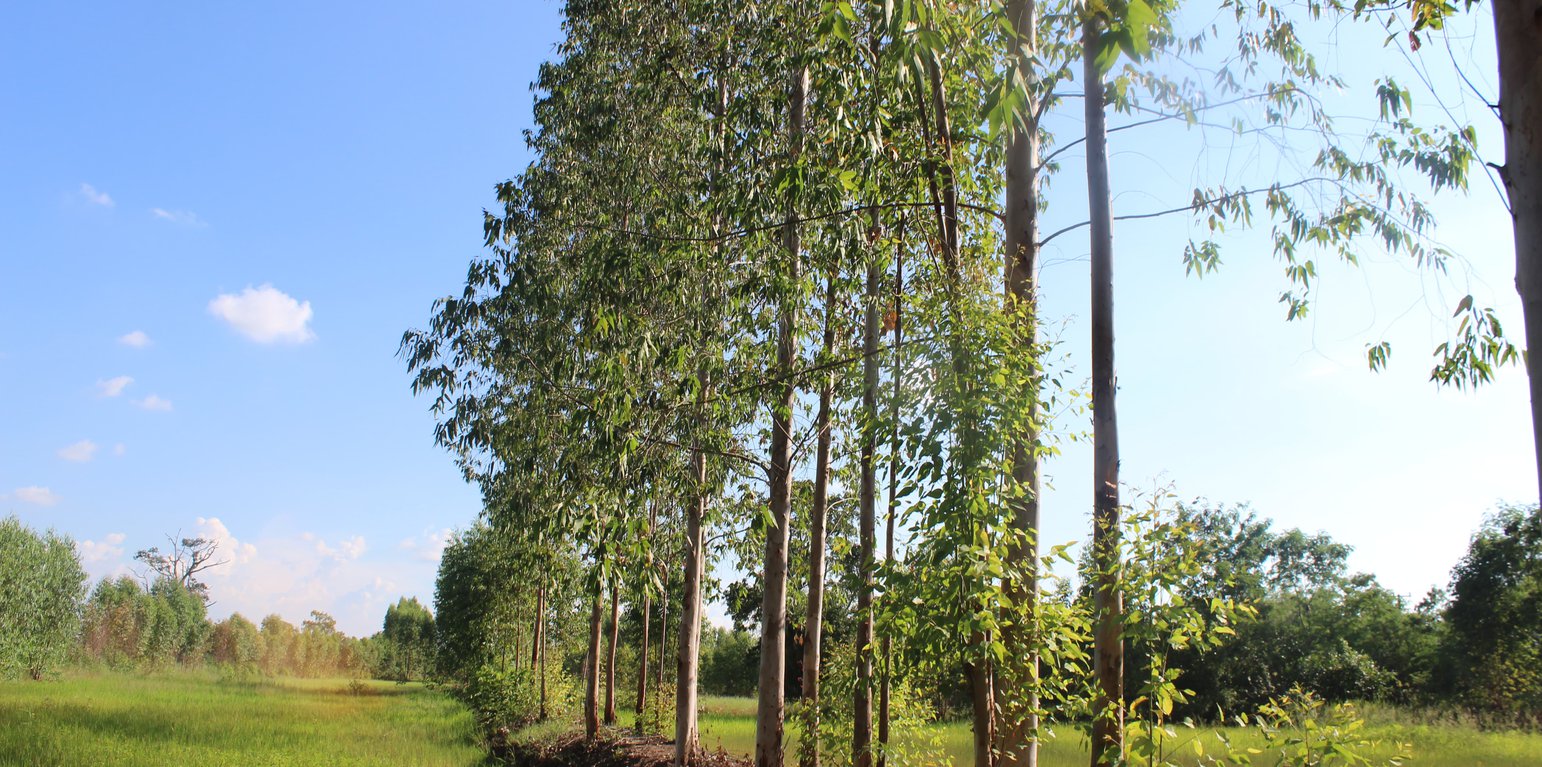Planting Eucalyptus on rice bunds for lowering shallow saline groundwater level in the Northeast of Thailand.
(ไทย)
Planting perennial salt-tolerant trees in the salt-affected areas in the Northeast of Thailand.
คำอธิบาย
Eucalyptus camaldulensis variety H4 is salt tolerant and has the ability to lower shallow saline groundwater levels; as a result salinity is controlled. Planting eucalyptus on one or two sides of the rice bund in an east-west direction (in single or double rows) at a spacing of 2 m between trees is the most effective technique and well accepted by farmers.
Eucalyptus camaldulensis cultivation on rice bunds to lower shallow saline groundwater levels in low-lying areas is a technology used on salt-affected land. The LDD Perennial Tree Planting project to promote the technology of planting Eucalyptus camaldulensis on rice bunds has been implemented since 1996. The land user interviewed cultivates a moderately salt-affected rice field at Ban Muang Pia District, Khon Kaen Province. The land is used for rice production both glutinous (variety RD 6) and non-glutinous fragrant rice (Hom Mali 105). The average yield of rice is 200-250 kg/rai (1 ha = 6.25 rai). The farmers have planted eucalyptus on bunds in the rice cultivated areas on about 10,000 rai in more than 10 years with the objectives of remedying and preventing salination by lowering shallow saline groundwater levels, through "bio-drainage" as well as increasing income and better utilization of lands on rice bunds for growing trees.
The technology of eucalyptus cultivation on rice bunds has been implemented in farmers' fields in the low-lying salt-affected rice area common in the Northeast of Thailand. It is widely accepted by farmers through the joint partnership between the Land Development Department (LDD), Siam Forestry Co., Ltd. and the local district administration. Eucalyptus seedlings are provided by LDD and are planted in a single or double rows - double rows with trees planted on two sides of the rice bunds in a zigzag manner following an east-west direction to prohibit a shadow effect. The spacing between the trees in a row is 2 m: the rice bund was adapted to be 1.5 m wide and 0.5 m high. This provides more space and convenient access to the rice field. The project provides labour costs for farmers to prepare the land before planting. Many farmers outside the project transplanted their own eucalyptus seedlings on the bunds of 0.5 m or more in width. Farmers buy the seedlings at 1 THB each and plant in pits of 0.3 x 0.3 x 0.3 m with 0.5 kg compost and 0.5 kg rice husks from farm by-products. This technology is well accepted by farmers because of the effective control of salinity in the rice fields as well as the higher income obtained from selling eucalyptus wood. Farmers observed the dead patchy spots of rice plants with salt crusts before planting eucalyptus: after 2 cutting cycles no salt patches were observed anymore, and rice yields increased noticeably. There was also extra income from selling poles of eucalyptus every 4 years. The average yield of eucalyptus trees of 2.5-3.0 inches in diameter was 16 tons per rai for the first cutting.
Based on 7 years (2 crops of eucalyptus coppicing), the average additional income was 1,087 THB/rai/yr (according to the farmers' and Siam Forest's information). The main investment was in the first year of planting; later on, the maintenance cost was on labour for weeding, pruning and thinning to 3 stems after coppice/cutting, including adding 15-15-15 fertilizer for each tree. The average income is increased through better rice yields. The benefits of the technology according to interviews are creating a cooler microclimate from eucalyptus trees and changes in biodiversity through better soil quality resulting in more species of flora and fauna such as grasses, wildflowers, dragonflies, earthworms in the rice field and on the bund. Some farmers wanted more trees by planting at closer spacing of 1 m, but this resulted in too great a density of trees thus consuming more surface water and competing with rice for water consumptive use.
สถานที่
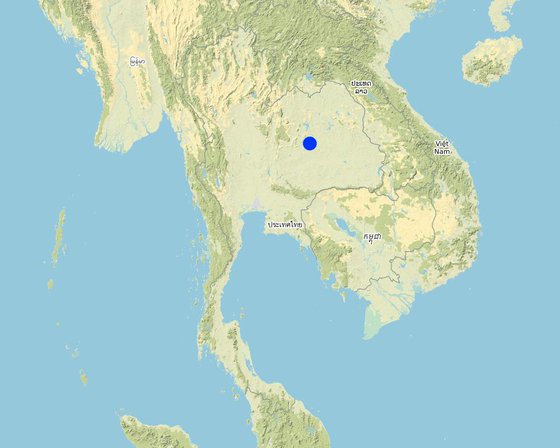
สถานที่: Ban Phai, Khon Kaen, ไทย
ตำนวนการวิเคราะห์เทคโนโลยี: พื้นที่เดี่ยว
ตำแหน่งทางภูมิศาสตร์ของสถานที่ที่ถูกเลือ
การเผยแพร่ของเทคโนโลยี: กระจายไปอย่างสม่ำเสมอในพื้นที่ (approx. 1-10 ตร.กม.)
วันที่ในการดำเนินการ: 1996
ประเภทของการแนะนำ
-
ด้วยการริเริ่มของผู้ใช้ที่ดินเอง
-
เป็นส่วนหนึ่งของระบบแบบดั้งเดิมที่ทำก้นอยู่ (> 50 ปี)
-
ในช่วงการทดลองหรือการทำวิจัย
-
ทางโครงการหรือจากภายนอก
-
by other land users
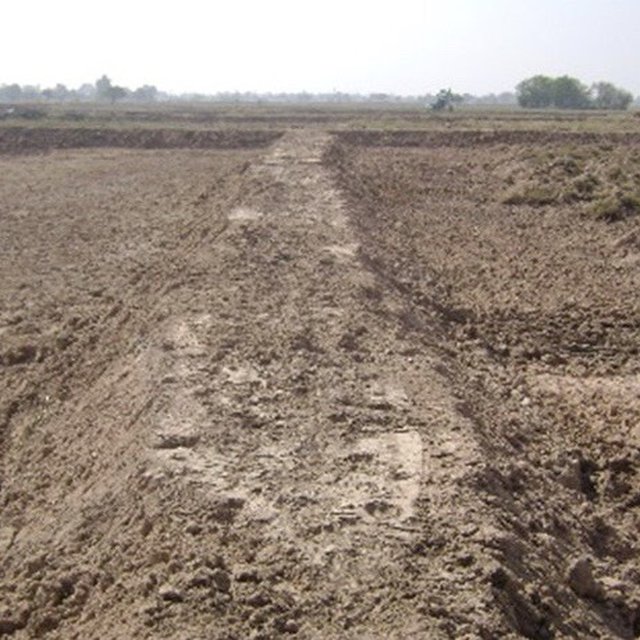
Land preparation of rice bunds before planting eucalyptus and rice. (Weera Rophandung)
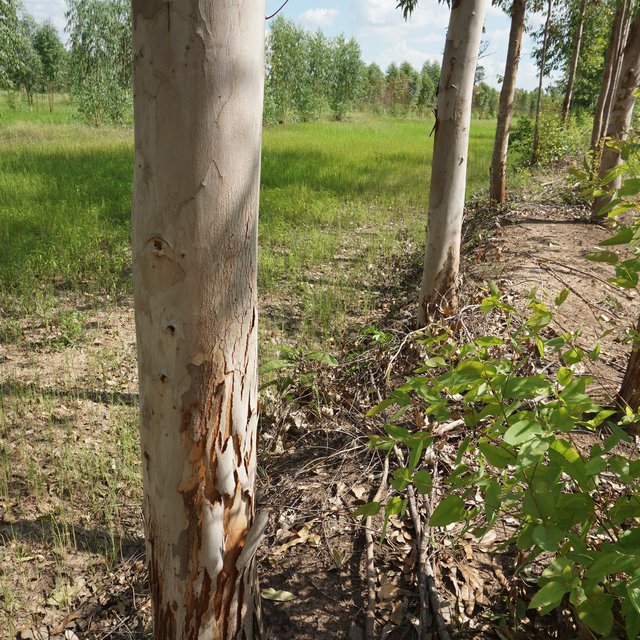
Planting eucalyptus on double rows (Supranee Sritumboon)
จุดประสงค์หลัก
-
ปรับปรุงการผลิตให้ดีขึ้น
-
ลด ป้องกัน ฟื้นฟู การเสื่อมโทรมของที่ดิน
-
อนุรักษ์ระบบนิเวศน์
-
ป้องกันพื้นที่ลุ่มน้ำ/บริเวณท้ายน้ำ โดยร่วมกับเทคโนโลยีอื่นๆ
-
รักษาสภาพหรือปรับปรุงความหลากหลายทางชีวภาพ
-
ลดความเสี่ยงของภัยพิบัติ
-
ปรับตัวเข้ากับการเปลี่ยนแปลงภูมิอากาศของโลก สภาพภูมิอากาศที่รุนแรงและผลกระทบ
-
ชะลอการเปลี่ยนแปลงภูมิอากาศของโลกและผลกระทบ
-
สร้างผลกระทบทางด้านเศรษฐกิจที่เป็นประโยชน์
-
สร้างผลกระทบทางด้านสังคมที่เป็นประโยชน์
การใช้ที่ดิน
-
พื้นที่ปลูกพืช - การปลูกพืชล้มลุกอายุปีเดียว, การปลูกพืชยืนต้นที่ไม่มีเนื้อไม้
พืชหลัก (พืชเศรษฐกิจและพืชอาหาร): Rice
การใช้น้ำ
-
จากน้ำฝน
-
น้ำฝนร่วมกับการชลประทาน
-
การชลประทานแบบเต็มรูปแบบ
จำนวนของฤดูปลูกต่อปี:
1
การใช้ที่ดินก่อนการดำเนินการโดยเทคโนโลยี:
Before planting eucalyptus, rice was the only crop. Due to the shallow saline groundwater of the area, rice had shown symptoms of being salt-affected; however after planting eucalyptus trees, these symptoms disappeared.
ความหนาแน่นของปศุสัตว์:
Only few cattle, swine, and boar are in the land user's farm.
ความมุ่งหมายที่เกี่ยวข้องกับการเสื่อมโทรมของที่ดิน
-
ป้องกันความเสื่อมโทรมของที่ดิน
-
ลดความเสื่อมโทรมของดิน
-
ฟื้นฟูบำบัดที่ดินที่เสื่อมโทรมลงอย่างมาก
-
ปรับตัวกับสภาพความเสื่อมโทรมของที่ดิน
-
ไม่สามารถใช้ได้
ที่อยู่ของการเสื่อมโทรม
-
การเสื่อมโทรมของดินทางด้านเคมี - Cn (Fertility decline): ความอุดมสมบูรณ์และปริมาณอินทรียวัตถุในดินถูกทำให้ลดลงไป (ไม่ได้เกิดจากสาเหตุการกัดกร่อน), Cs (Salinization/alkalinization): การสะสมเกลือหรือการทำให้เป็นด่าง
-
การเสื่อมโทรมของดินทางด้านกายภาพ - Pc (Compaction): การอัดแน่น, Pk (Slaking and crusting): การอุดตันของช่องว่างในดินหรือรูพรุน
-
การเสื่อมโทรมของดินทางด้านชีวภาพ - Bc (Reduction of vegetation cover): การลดลงของจำนวนพืชที่ปกคลุมดิน , Bq (Quantity/biomass decline): การลดลงของปริมาณหรือมวลชีวภาพ, Bs (Quality and species composition): องค์ประกอบหรือความหลากหลายทางคุณภาพและชนิดพันธุ์ลดลง, Bl (Loss of soil life): การสูญเสียสิ่งมีชีวิตในดิน
-
การเสื่อมโทรมของน้ำ - Hg (Change in groundwater): การเปลี่ยนแปลงของน้ำบาดาลหรือระดับน้ำในแอ่งน้ำบาดาล, Hq (Decline of groundwater quality): การลดลงของคุณภาพน้ำบาดาล
กลุ่ม SLM
-
การปลูกป่าร่วมกับพืช
-
การจัดการน้ำบาดาล
-
desalination
มาตรการ SLM
-
มาตรการจัดการพืช - A2: อินทรียวัตถุในดิน/ความอุดมสมบูรณ์ในดิน, A5: การจัดการเมล็ดพันธุ์ การปรับปรุงพันธุ์
| | | | | | | | | | | |
|
แบบแปลนทางเทคนิค
ข้อมูลจำเพาะด้านเทคนิค
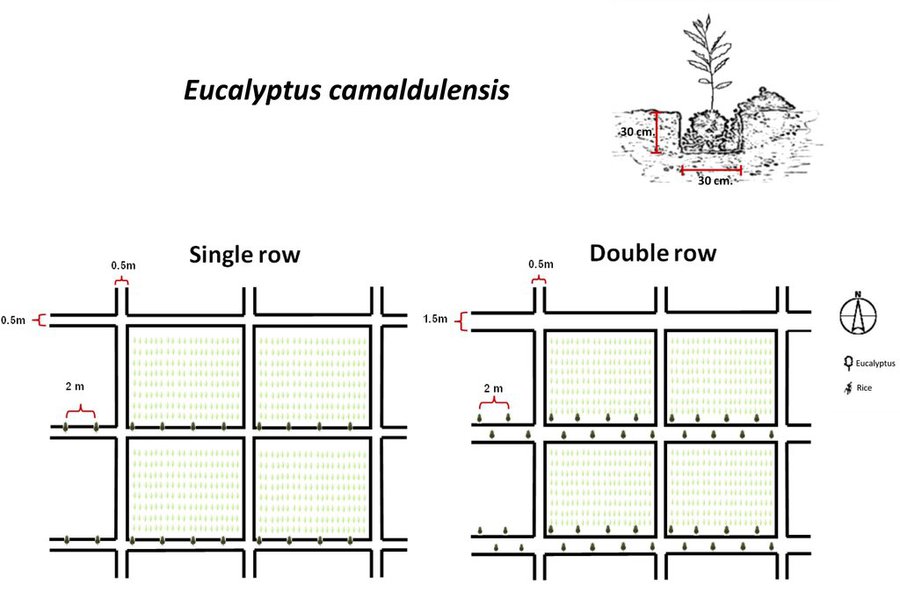
ผู้เขียน Chettaruj Janplang
1. Seedling of Eucalyptus camaldulensis H4, a salt-tolerant variety, were planted. The age of seedlings was 3-month old. The rice bund was regulated to 0.5 m wide for planting eucalyptus in single row or 1.5 m wide for planting in double rows (in a zigzag manner), 0.5 m high with a spacing of 2 m between the trees along an east-west direction. The number of trees was 80/rai or 500/ha for double rows planting.
2. Planting technique: 0.5 kg of compost mixed with 0.5 kg of rice husks was applied at the bottom of a pit of 0.3 x 0.3 x 0.3 m before seedlings were planted.
|
การจัดตั้งและการบำรุงรักษา: กิจกรรม ปัจจัยและค่าใช้จ่าย
การคำนวนต้นทุนและค่าใช้จ่าย
- ค่าใช้จ่ายถูกคำนวน ต่อพื้นที่ที่ใช้เทคโนโลยี (หน่วยของขนาดและพื้นที่: own by one selected land userตัวแปลงค่าจาก 1 เฮกตาร์ = 1 hectare = 6.25 rai)
- สกุลเงินที่ใช้คำนวณค่าใช้จ่าย THB
- อัตราแลกเปลี่ยน (ไปเป็นดอลลาร์สหรัฐ) คือ 1 ดอลลาร์สหรัฐ = 32.0 THB
- ค่าจ้างเฉลี่ยในการจ้างแรงงานต่อวันคือ 300 THB
ปัจจัยที่สำคัญที่สุดที่มีผลต่อค่าใช้จ่าย
Maintenance cost of weeding, pruning, thinning and fertilizer application was 428 THB/rai/yr. Calculation is based on 7 years of planting. Four years after planting, the logs were sold for additional income 5,714.3 THB/rai. On the 7th year, the logs were sold at 4,285.7 THB/rai.
(Income from 2 times of Eucalyptus sale; 4th year = 40,000 THB, 7th year = 30,000 THB. Therefore, total income for 7 years = 10,000 THB/rai. Benefit from Eucalyptus planting = 10,000–2,388 (planting cost + 4 years of maintenance cost) = 7,612 THB/7 years = 1,087 THB/rai/yr.)
Compost and rice husk are from farm by-products and the labour costs are from land users. The income thereore will be higher than 1,087 THB/rai as estimated.
กิจกรรมเพื่อการจัดตั้ง
-
Site selection of salt-affected area (ช่วงระยะเวลา/ความถี่: May-July)
-
Land preparation; bunds construction and seedling preparation (ช่วงระยะเวลา/ความถี่: May-July)
-
Public hearing, joint meeting between farmers and researchers (ช่วงระยะเวลา/ความถี่: May-July)
-
Demonstration plot (ช่วงระยะเวลา/ความถี่: May-July)
-
Model establishment (Eucalyptus planting method) (ช่วงระยะเวลา/ความถี่: May-July)
-
Joint monitoring, evaluation and follow up for planting (ช่วงระยะเวลา/ความถี่: After planting)
ปัจจัยและค่าใช้จ่ายของการจัดตั้ง (per own by one selected land user)
| ปัจจัยนำเข้า |
หน่วย |
ปริมาณ |
ค่าใช้จ่ายต่อหน่วย (THB) |
ค่าใช้จ่ายทั้งหมดต่อปัจจัยนำเข้า (THB) |
%ของค่าใช้จ่ายที่ก่อให้เกิดขึ้นโดยผู้ใช้ที่ดิน |
|
แรงงาน
|
| Labour cost for planting eucalyptus (labour wage per day = 300 THB, 1 rai required a labour cost of 600 THB) |
Rai |
1.0 |
600.0 |
600.0 |
|
|
วัสดุด้านพืช
|
| Eucalyptus seedling cost (80 trees/rai), 1 THB for each seedling |
Seedling |
80.0 |
1.0 |
80.0 |
|
|
ปุ๋ยและสารฆ่า/ยับยั้งการเจริญเติบโตของสิ่งมีชีวิต (ไบโอไซด์)
|
| Compost cost 3.5 THB/kg, 0.5 kg/pit |
kg |
40.0 |
3.5 |
140.0 |
|
| Rice husk cost 4 THB/kg, 0.5 kg/pit |
kg |
40.0 |
4.0 |
160.0 |
|
| ค่าใช้จ่ายทั้งหมดของการจัดตั้งเทคโนโลยี |
980.0 |
|
กิจกรรมสำหรับการบำรุงรักษา
-
Thinning and pruning after first year of planting (ช่วงระยะเวลา/ความถี่: 2 times/rain season)
-
Weeding after first year of planting (ช่วงระยะเวลา/ความถี่: 2 times/rain season)
-
Fertilizer application after first year of planting (ช่วงระยะเวลา/ความถี่: 2 times/rain season)
-
Cutting and selling logs (ช่วงระยะเวลา/ความถี่: 4th and 7th year)
ปัจจัยและค่าใช้จ่ายของการบำรุงรักษา (per own by one selected land user)
| ปัจจัยนำเข้า |
หน่วย |
ปริมาณ |
ค่าใช้จ่ายต่อหน่วย (THB) |
ค่าใช้จ่ายทั้งหมดต่อปัจจัยนำเข้า (THB) |
%ของค่าใช้จ่ายที่ก่อให้เกิดขึ้นโดยผู้ใช้ที่ดิน |
|
แรงงาน
|
| Labour cost of weeding, pruning, thinning, and fertilizer application for 150 THB/time, 2 times/rai/yr, based on the labour wage of 300 THB/day |
Time |
2.0 |
150.0 |
300.0 |
|
|
ปุ๋ยและสารฆ่า/ยับยั้งการเจริญเติบโตของสิ่งมีชีวิต (ไบโอไซด์)
|
| Cost of 15-15-15 chemical fertilizer (13 THB/kg, application rate 50 g/tree; 50 g x 80 trees per rai = 4 kg/rai |
kg |
4.0 |
13.0 |
52.0 |
|
| ค่าใช้จ่ายทั้งหมดของการบำรุงรักษาสภาพเทคโนโลยี |
352.0 |
|
สิ่งแวดล้อมทางธรรมชาติ
ปริมาณน้ำฝนเฉลี่ยรายปี
-
< 250 ม.ม.
-
251-500 ม.ม.
-
501-750 ม.ม.
-
751-1,000 ม.ม.
-
1,001-1,500 ม.ม.
-
1,501-2,000 ม.ม.
-
2,001-3,000 ม.ม.
-
3,001-4,000 ม.ม.
-
> 4,000 ม.ม.
เขตภูมิอากาศเกษตร
-
ชื้น
-
กึ่งชุ่มชื้น
-
กึ่งแห้งแล้ง
-
แห้งแล้ง
ข้อมูลจำเพาะเรื่องภูมิอากาศ
ปริมาณเฉลี่ยฝนรายปีในหน่วยมม. 1200.0
Average annual rainfall from 2003-2012
ชื่อสถานีอุตุนิยมวิทยา Meteorological Department
Average temperature 21-36 degree Celsius, relative humidity is 75%
ความชัน
-
ราบเรียบ (0-2%)
-
ลาดที่ไม่ชัน (3-5%)
-
ปานกลาง (6-10%)
-
เป็นลูกคลื่น (11-15%)
-
เป็นเนิน (16-30%)
-
ชัน (31-60%)
-
ชันมาก (>60%)
ภูมิลักษณ์
-
ที่ราบสูง/ที่ราบ
-
สันเขา
-
ไหล่เขา
-
ไหล่เนินเขา
-
ตีนเนิน
-
หุบเขา
ความสูง
-
0-100 เมตร
-
101-500 เมตร
-
501-1,000 เมตร
-
1,001-1,500 เมตร
-
1,501-2,000 เมตร
-
2,001-2,500 เมตร
-
2,501-3,000 เมตร
-
3,001-4,000 เมตร
-
> 4,000 เมตร
เทคโนโลยีถูกประยุกต์ใช้ใน
-
บริเวณสันเขา (convex situations)
-
บริเวณแอ่งบนที่ราบ (concave situations)
-
ไม่เกี่ยวข้อง
ความลึกของดิน
-
ตื้นมาก (0-20 ซ.ม.)
-
ตื้น (21-50 ซ.ม.)
-
ลึกปานกลาง (51-80 ซ.ม.)
-
ลึก (81-120 ซ.ม.)
-
ลึกมาก (>120 ซ.ม.)
เนื้อดิน (ดินชั้นบน)
-
หยาบ/เบา (ดินทราย)
-
ปานกลาง (ดินร่วน ทรายแป้ง)
-
ละเอียด/หนัก (ดินเหนียว)
เนื้อดิน (> 20 ซม. ต่ำกว่าพื้นผิว)
-
หยาบ/เบา (ดินทราย)
-
ปานกลาง (ดินร่วน ทรายแป้ง)
-
ละเอียด/หนัก (ดินเหนียว)
สารอินทรียวัตถุในดิน
-
สูง (>3%)
-
ปานกลาง (1-3%)
-
ต่ำ (<1%)
น้ำบาดาล
-
ที่ผิวดิน
-
<5 เมตร
-
5-50 เมตร
-
> 50 เมตร
ระดับน้ำบาดาลที่ผิวดิน
-
เกินพอ
-
ดี
-
ปานกลาง
-
ไม่ดีหรือไม่มีเลย
คุณภาพน้ำ (ยังไม่ได้รับการบำบัด)
-
เป็นน้ำเพื่อการดื่มที่ดี
-
เป็นน้ำเพื่อการดื่มที่ไม่ดี (จำเป็นต้องได้รับการบำบัด)
-
เป็นน้ำใช้เพื่อการเกษตรเท่านั้น (การชลประทาน)
-
ใช้ประโยชน์ไม่ได้
ความเค็มของน้ำเป็นปัญหาหรือไม่?
การเกิดน้ำท่วม
ความหลากหลายทางชนิดพันธุ์
ความหลากหลายของแหล่งที่อยู่
ลักษณะเฉพาะของผู้ใช้ที่ดินที่ประยุกต์ใช้เทคโนโลยี
เป้าหมายทางการตลาด
-
เพื่อการยังชีพ (หาเลี้ยงตนเอง)
-
ผสม (การเลี้ยงชีพ/ทำการค้า)
-
ทำการค้า/การตลาด
รายได้จากภายนอกฟาร์ม
-
< 10% ของรายได้ทั้งหมด
-
10-50% ของรายได้ทั้งหมด
-
> 50% ของรายได้ทั้งหมด
ระดับของความมั่งคั่งโดยเปรียบเทียบ
-
ยากจนมาก
-
จน
-
พอมีพอกิน
-
รวย
-
รวยมาก
ระดับของการใช้เครื่องจักรกล
-
งานที่ใช้แรงกาย
-
การใช้กำลังจากสัตว์
-
การใช้เครื่องจักรหรือเครื่องยนต์
อยู่กับที่หรือเร่ร่อน
-
อยู่กับที่
-
กึ่งเร่ร่อน
-
เร่ร่อน
เป็นรายบุคคลหรือกลุ่ม
-
เป็นรายบุคคล/ครัวเรือน
-
กลุ่ม/ชุมชน
-
สหกรณ์
-
ลูกจ้าง (บริษัท รัฐบาล)
อายุ
-
เด็ก
-
ผู้เยาว์
-
วัยกลางคน
-
ผู้สูงอายุ
พื้นที่ที่ใช้ต่อครัวเรือน
-
< 0.5 เฮกตาร์
-
0.5-1 เฮกตาร์
-
1-2 เฮกตาร์
-
2-5 เฮกตาร์
-
5-15 เฮกตาร์
-
15-50 เฮกตาร์
-
50-100 เฮกตาร์
-
100-500 เฮกตาร์
-
500-1,000 เฮกตาร์
-
1,000-10,000 เฮกตาร์
-
>10,000 เฮกตาร์
ขนาด
-
ขนาดเล็ก
-
ขนาดกลาง
-
ขนาดใหญ่
กรรมสิทธิ์ในที่ดิน
-
รัฐ
-
บริษัท
-
เป็นแบบชุมชนหรือหมู่บ้าน
-
กลุ่ม
-
รายบุคคล ไม่ได้รับสิทธิครอบครอง
-
รายบุคคล ได้รับสิทธิครอบครอง
สิทธิในการใช้ที่ดิน
-
เข้าถึงได้แบบเปิด (ไม่ได้จัดระเบียบ)
-
เกี่ยวกับชุมชน (ถูกจัดระเบียบ)
-
เช่า
-
รายบุคคล
สิทธิในการใช้น้ำ
-
เข้าถึงได้แบบเปิด (ไม่ได้จัดระเบียบ)
-
เกี่ยวกับชุมชน (ถูกจัดระเบียบ)
-
เช่า
-
รายบุคคล
-
rainfed
เข้าถึงการบริการและโครงสร้างพื้นฐาน
ความช่วยเหลือทางด้านเทคนิค
การจ้างงาน (เช่น ภายนอกฟาร์ม)
ผลกระทบ
ผลกระทบทางด้านเศรษฐกิจและสังคม
การผลิตพืชผล
จำนวนก่อน SLM: Rice production before planting eucalyptus 150-200 kg/rai
หลังจาก SLM: Rice production after planting eucalyptus 200-250 kg/rai
The increase in rice production was due to being less saline condition of the field.
คุณภาพพืชผล
จำนวนก่อน SLM: More unfilled grain of rice
หลังจาก SLM: Less unfilled grain of rice
Increased about 10%
การผลิตพืชที่ใช้เลี้ยงปศุสัตว์
จำนวนก่อน SLM: Less stubble
หลังจาก SLM: More stubble
Increased about 10%
ความหลากหลายของผลิตภัณฑ์
จำนวนก่อน SLM: Only rice was grown before SLM
หลังจาก SLM: Rice and Eucalyptus
Increased about 50%, Eucalyptus grown in east-west direction only.
พื้นที่สำหรับการผลิต (ที่ดินใหม่ที่อยู่ในระหว่างเพาะปลูกหรือใช้งาน)
จำนวนก่อน SLM: 0%
หลังจาก SLM: 50%
Rice bunds were unused before planting eucalyptus.
การจัดการที่ดิน
จำนวนก่อน SLM: 0%
หลังจาก SLM: 10%
Planting trees hinder access to the rice field.
คุณภาพน้ำดื่ม
จำนวนก่อน SLM: None
หลังจาก SLM: No effect
From rain water
การมีน้ำไว้ให้สำหรับการชลประทาน
No supplementary water available
คุณภาพน้ำสำหรับการชลประทาน
ความต้องการน้ำจากการชลประทาน
ค่าใช่จ่ายของปัจจัยการผลิตทางการเกษตร
จำนวนก่อน SLM: 0%
หลังจาก SLM: 20%
Increased about 20% (the cost for planting trees in the first year and the maintenance cost of later years).
รายได้จากฟาร์ม
จำนวนก่อน SLM: 0
หลังจาก SLM: Approximately 1,000 THB/rai/yr
Additional income from selling eucalyptus logs besides rice
ความหลากหลายของแหล่งผลิตรายได้
จำนวนก่อน SLM: Income from only rice
หลังจาก SLM: Income from both rice and logs
Extra income from selling swine and boar
ภาระงาน
จำนวนก่อน SLM: 0%
หลังจาก SLM: 10%
Increased about 10% by planting tree and subsequent maintainence.
ผลกระทบด้านสังคมและวัฒนธรรม
ความมั่นคงด้านอาหาร / พึ่งตนเองได้
จำนวนก่อน SLM: 0%
หลังจาก SLM: 10%
Self-sufficiency increased through obtaining higher income.
สถานการณ์ด้านสุขภาพ
จำนวนก่อน SLM: 0%
หลังจาก SLM: 10%
Change in microclimate affected in cooler atmosphere
โอกาสทางด้านสันทนาการ
จำนวนก่อน SLM: 0%
หลังจาก SLM: 10%
Due to change in microclimate and biodiversity
สถาบันของชุมชน
จำนวนก่อน SLM: 0%
หลังจาก SLM: 20%
More communication among land users community and local administration.
สถาบันแห่งชาติ
จำนวนก่อน SLM: 0%
หลังจาก SLM: 10%
National institutions are more recognized by land users.
SLM หรือความรู้เรื่องความเสื่อมโทรมของที่ดิน
จำนวนก่อน SLM: 0%
หลังจาก SLM: 50%
Land users observed less salination.
ผลกระทบด้านนิเวศวิทยา
การระบายน้ำส่วนเกิน
จำนวนก่อน SLM: 0%
หลังจาก SLM: 10%
Saline groundwater level decreased due to the bio-drainage by eucalyptus trees.
น้ำบาดาลหรือระดับน้ำในแอ่งน้ำบาดาล
จำนวนก่อน SLM: Ave. groundwater level < 1 m
หลังจาก SLM: Ave. groundwater level > 1 m
Lower groundwater level after 7 years of planting eucalyptus
การระเหย
จำนวนก่อน SLM: 0%
หลังจาก SLM: 10%
Cooler atmosphere
ความชื้นในดิน
จำนวนก่อน SLM: 0%
หลังจาก SLM: 10%
Due to shading
สิ่งปกคลุมดิน
จำนวนก่อน SLM: 0%
หลังจาก SLM: 10%
Shading effect and plant residues
การเกิดแผ่นแข็งที่ผิวดิน /การเกิดชั้นดาน
จำนวนก่อน SLM: 0%
หลังจาก SLM: 10%
Due to better soil properties from crop residues and earthworm activities
การอัดแน่นของดิน
จำนวนก่อน SLM: 0%
หลังจาก SLM: 10%
Due to better soil properties from crop residues and earthworm activities
การหมุนเวียนและการเติมของธาตุอาหาร
จำนวนก่อน SLM: 0%
หลังจาก SLM: 10%
ความเค็ม
จำนวนก่อน SLM: 0%
หลังจาก SLM: 30%
Rice production as well as quality of rice increased (and also more percentage of full grains) due to the decrease in salinity level.
การปกคลุมด้วยพืช
จำนวนก่อน SLM: 0%
หลังจาก SLM: 50%
Rice bunds are used for planting eucalyptus only along east-west direction.
มวลชีวภาพ/เหนือดินชั้น C
จำนวนก่อน SLM: 0%
หลังจาก SLM: 80%
Biomass from eucalyptus trees
ความหลากหลายทางชีวภาพของพืช
จำนวนก่อน SLM: 0%
หลังจาก SLM: 60%
From eucalyptus trees and more local species of grasses and wildflowers
ความหลากหลายทางชีวภาพของสัตว์
จำนวนก่อน SLM: 0%
หลังจาก SLM: 50%
Earthworms, birds, rats, ants, etc.
ชนิดพันธุ์ที่ให้ประโยชน์ (ผู้ล่า ไส้เดือนดิน แมลงผสมเกสร)
จำนวนก่อน SLM: 0%
หลังจาก SLM: 10%
Native earthworms
ความหลากหลายของสัตว์
จำนวนก่อน SLM: 0%
หลังจาก SLM: 20%
Dragonfly, earthworms, birds and rats
ผลกระทบจากภัยแล้ง
จำนวนก่อน SLM: 0%
หลังจาก SLM: 10%
Due to cooler atmosphere of the planting sites
การปล่อยคาร์บอนและก๊าซเรือนกระจก
จำนวนก่อน SLM: 0%
หลังจาก SLM: 20%
Eucalyptus trees absorb greenhouse gases.
ภูมิอากาศจุลภาค
จำนวนก่อน SLM: 0%
หลังจาก SLM: 20%
Cooler and greener atmosphere
ผลกระทบนอกพื้นที่ดำเนินการ
การเกิดมลพิษในน้ำบาดาลหรือแม่น้ำ
จำนวนก่อน SLM: 0%
หลังจาก SLM: 10%
Reduced groundwater level
ผลกระทบของก๊าซเรือนกระจก
จำนวนก่อน SLM: 0%
หลังจาก SLM: 10%
The planted Eucalyptus trees absorb greenhouse gases.
รายได้และค่าใช้จ่าย
ผลประโยชน์ที่ได้รับเปรียบเทียบกับค่าใช้จ่าย
ผลตอบแทนระยะสั้น
ด้านลบอย่างมาก
ด้านบวกอย่างมาก
ผลตอบแทนระยะยาว
ด้านลบอย่างมาก
ด้านบวกอย่างมาก
ผลประโยชน์ที่ได้รับเปรียบเทียบกับค่าใช้จ่ายในการบำรุงรักษา
ผลตอบแทนระยะสั้น
ด้านลบอย่างมาก
ด้านบวกอย่างมาก
ผลตอบแทนระยะยาว
ด้านลบอย่างมาก
ด้านบวกอย่างมาก
การเปลี่ยนแปลงของสภาพภูมิอากาศ
สภาพรุนแรงของภูมิอากาศ (ภัยพิบัติ)
ผลลัพธ์ตามมาที่เกี่ยวข้องกับภูมิอากาศอื่น ๆ
ช่วงการปลูกพืชที่ขยายออกไป
การน้อมเอาความรู้และการปรับใช้
เปอร์เซ็นต์ของผู้ใช้ที่ดินในพื้นที่ที่นำเทคโนโลยีไปใช้
-
ครั้งเดียวหรือเป็นการทดลอง
-
1-10%
-
10-50%
-
มากกว่า 50%
จากทั้งหมดที่ได้รับเทคโนโลยีเข้ามามีจำนวนเท่าใดที่ทำแบบทันที โดยไม่ได้รับการจูงใจด้านวัสดุหรือการเงินใดๆ?
-
0-10%
-
10-50%
-
50-90%
-
90-100%
จำนวนหลังคาเรือนหรือขนาดพื้นที่รวมทั้งหมด
1,600 ha
เทคโนโลยีได้รับการปรับเปลี่ยนเร็วๆ นี้เพื่อให้ปรับตัวเข้ากับสภาพที่กำลังเปลี่ยนแปลงหรือไม่?
สภาพที่กำลังเปลี่ยนแปลงอันไหน?
-
การเปลี่ยนแปลงแบบค่อยเป็นค่อยไปและสภาพรุนแรงของภูมิอากาศ
-
การเปลี่ยนแปลงของตลาด
-
การมีแรงงานไว้ให้ใช้ (เนื่องจากการอพยพย้ายถิ่นฐาน)
-
closer spacing of trees
Planting eucalyptus has been adapted from growing eucalyptus on rice bunds of 1.5 m wide to 0.5 m wide to save labor cost of land preparation and plant the seedlings on one row instead of 2 rows.
บทสรุปหรือบทเรียนที่ได้รับ
จุดแข็ง: มุมมองของผู้ใช้ที่ดิน
-
Decrease saline groundwater level resulting in rice yield increase.
-
Get higher income from increasing rice yield and eucalyptus poles.
-
The microclimate in the area has been improved and the air is cooler and the land is greener.
-
Increased indirect returns due to land is greener and used as animal fodders for cattle, swine, and boar.
จุดแข็ง: ทัศนคติของผู้รวบรวมหรือวิทยากรคนอื่นๆ
-
Decreased saline groundwater level then prevented further salination as a result to protect the land degradation.
-
Increasing farmer's income.
-
To establish better environment for more biodiversity especially earthworms used to disappear now are found and their activities induce better soil properties.
จุดด้อย/ข้อเสีย/ความเสี่ยง: มุมมองของผู้ใช้ที่ดินแก้ไขปัญหาได้อย่างไร
-
More birds and rats damage rice yield.
No solution
-
The officers do not visit whenever the land users need help.
The officers need to contact the land users and give advice more often.
จุดด้อย/ข้อเสีย/ความเสี่ยง: ทัศนคติของผู้รวบรวมหรือวิทยากรคนอื่นๆแก้ไขปัญหาได้อย่างไร
-
Farmers do not understand how eucalyptus trees could decrease saline groundwater level.
Explain, illustrate and demonstrate the cause and effect of salinity.
-
There are pros and cons of planting eucalyptus because the leaves may damage the soil and their shading effect may decrease rice yield.
Organize farmer group visit to some successful sites that no adverse effects have been found.
การอ้างอิง
ผู้ตรวจสอบ
-
Rima Mekdaschi Studer
-
Samran Sombatpanit
-
Pitayakon Limtong
-
William Critchley
วันที่จัดทำเอกสาร: 3 ตุลาคม 2018
การอัพเดทล่าสุด: 29 ธันวาคม 2020
วิทยากร
-
Sayan Chuenchai - ผู้ใช้ที่ดิน
-
Supranee Sritumboon (ssritumboon@yahoo.com) - ผู้เชี่ยวชาญ SLM
-
Pornpana Pothinam (laosuwan18@hotmail.com) - ผู้เชี่ยวชาญ SLM
-
Weera Rophandung (weerop@hotmail.com) - ผู้เชี่ยวชาญ SLM
-
Pranee Srihaban (pranee.782@gmail.com) - ผู้เชี่ยวชาญ SLM
-
Usa Jakkarach (usa.kl@hotmail.com) - ผู้เชี่ยวชาญ SLM
-
Chettaruj Janplang (joeshua9@hotmail.com) - ผู้เชี่ยวชาญ SLM
-
Somsri Arunin (ssarunin@gmail.com) - National consultant
คำอธิบายฉบับเต็มในฐานข้อมูล WOCAT
การจัดทำเอกสารถูกทำโดย
องค์กร
- Land Development Department LDD (Land Development Department LDD) - ไทย
โครงการ
- Decision Support for Mainstreaming and Scaling out Sustainable Land Management (GEF-FAO / DS-SLM)
การอ้งอิงหลัก
-
Land Development Department: http://www.ldd.go.th/
ลิงก์ข้อมูลที่เกี่ยวข้องที่มีอยู่ในออนไลน์
